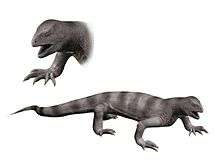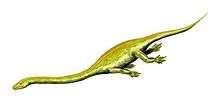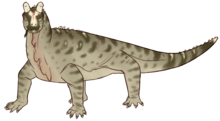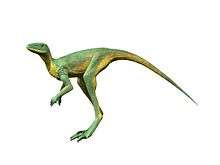Trilophosaurus
Trilophosaurus (Greek for "lizard with three ridges") is a lizard-like trilophosaurid allokotosaur known from the Late Triassic of North America. It was a herbivore up to 2.5 m long. It had a short, unusually heavily built skull, equipped with massive, broad flattened cheek teeth with sharp shearing surfaces for cutting up tough plant material. Teeth are absent from the premaxilla and front of the lower jaw, which in life were probably equipped with a horny beak.
.jpg)
| Trilophosaurus | |
|---|---|
| Skeleton of Trilophosaurus buettneri | |
| Scientific classification | |
| Kingdom: | Animalia |
| Phylum: | Chordata |
| Class: | Reptilia |
| Clade: | †Allokotosauria |
| Order: | †Trilophosauria |
| Family: | †Trilophosauridae |
| Genus: | †Trilophosaurus Case, 1928 |
| Type species | |
| †Trilophosaurus buettneri Case, 1928 | |
| Species | |
| |
| Synonyms | |
|
Synonyms of T. buettneri:
Synonyms of T. jacobsi:
| |
The skull is also unusual in that the lower temporal opening is missing, giving the appearance of a euryapsid skull. Because of this, the trilophosaurs were once classified with placodonts within Sauropterygia. Carroll (1988) suggested that the lower opening may have been lost to strengthen the skull.

Trilophosaurus is traditionally thought to include two valid species: the typical T. buettneri and the more robust T. jacobsi. In 1993, paleontologists Hans-Dieter Sues and Paul E. Olsen reassigned T. jacobsi, as well as two additional trilophosaurids (Tricuspisaurus and Variodens), to Procolophonidae based on similarities between its tricuspid teeth and those of the newly described procolophonid Xenodiphyodon.[1] This view persisted in subsequent publications[2] until the cranial material of T. jacobsi was described by Heckert et al. (2006). The new material confirmed the originally classification that T. jacobsi, as well as Tricuspisaurus and Variodens based on similarities to it, are indeed trilophosaurids.[3] Meanwhile, a third species of Trilophosaurus, T. dornorum, was named by Mueller & Parker (2006) based on teeth of a robust individual.[4] However, Spielmann et al. (2009) argued that the robustness of the new species is not sufficient to differentiate it from other Trilophosaurus species, especially in light of new robust specimens of T. jacobsi. Therefore, they considered T. dornorum to be a junior synonym of T. jacobsi,[5] a view that was maintained since in other publications.[6] Spielmann et al. (2006) redescribed the type material of Malerisaurus langstoni and concluded that it's indistinguishable from T. buettneri, and thus M. langstoni represents its synonym.[7]
Nesbitt et al. (2015) performed a phylogenetic analysis focusing on relations within Allokotosauria and recovered T. jacobsi to be more closely related to Spinosuchus caseanus than to the type species of Trilophosaurus. To further test this possibility, the types of S. caseanus and T. jacobsi were scored separately from the referred the Kahle Trilophosaurus Quarry elements (referred to T. jacobsi by Spielmann et al. (2008) or to S. caseanus by Spielmann et al. (2009)). A phylogenetic analysis recovered the three in a monophyletic clade to the exclusion of T. buettneri based on a single autapomorphy. Furthermore, the types of S. caseanus and T. jacobsi as well as the Kahle Quarry material all scored identically, suggesting that T. jacobsi not only should be reassigned to Spinosuchus, but in fact represents the junior synonym of its type and only species (S. caseanus). Nesbitt et al. (2015) refrained from officially synonymizing the two taxa pending further study of other advanced trilophosaurids.[6]
Sources
- Benton, M. J. (2000), Vertebrate Paleontology, 2nd ed. Blackwell Science Ltd, p. 144
- Carroll, R. L. (1988), Vertebrate Paleontology and Evolution, W.H. Freeman & Co. p. 266
- Sues, H.-D.; Olsen, P.E. (1993). "A new procolophonid and a new tetrapod of uncertain, possibly procolophonian affinities from the Upper Triassic of Virginia". Journal of Vertebrate Paleontology. 13 (3): 282–286. doi:10.1080/02724634.1993.10011510.
- Fraser, N.C. (1997). "Assemblages of small tetrapods from British Late Triassic fissure deposits". In Fraser, N.C.; Sues, H.-D. (eds.). In the Shadow of the Dinosaurs: Early Mesozoic Tetrapods. Cambridge and New York: Cambridge University Press. pp. 214–225. ISBN 9780521458993.
- Heckert, A.B.; Lucas, S.G.; Rinehart, L.F.; Spielmann, J.A.; Hunt, A.P.; Kahle, R. (2006). "Revision of the archosauromorph reptile Trilophosaurus, with a description of the first skull of Trilophosaurus jacobsi, from the Upper Triassic Chinle Group, West Texas, USA" (PDF). Palaeontology. 49 (3): 621–640. doi:10.1111/j.1475-4983.2006.00556.x.
- Müller, B. D. & Parker, W. G., 2006. A new species of Trilophosaurus (Diapsida: Archosauromorpha) from the Sonsela Member (Chinle Formation) of Petrified Forest National Park, Arizona. Museum of Northern Arizona, Bulletin 62:119-125.
- Spielmann, J.A., Lucas, S.G., Heckert, A.B., Rinehart, L.F., and Richards, H.R., III. 2009. Redescription of Spinosuchus caseanus (Archosauromorpha: Trilophosauridae) from the Upper Triassic of North America. Palaeodiversity 2:283-313.
- Nesbitt, S.J.; Flynn, J.J.; Pritchard, A.C.; Parrish, M.J.; Ranivoharimanana, L.; Wyss, A.R. (2015). "Postcranial osteology of Azendohsaurus madagaskarensis (?Middle to Upper Triassic, Isalo Group, Madagascar) and its systematic position among stem archosaur reptiles". Bulletin of the American Museum of Natural History (398): 1–126. doi:10.5531/sd.sp.15. hdl:2246/6624. ISSN 0003-0090.
- Spielmann, J.A., Lucas, S.G., Hunt, A.P., and Heckert. 2006. Reinterpretation of the holotype of Malerisaurus langstoni, a diapsid reptile from the Upper Triassic Chinle Group of West Texas. The Triassic-Jurassic Terrestrial Transition. New Mexico Museum of Natural History and Science, Bulletin 37:543-547.









